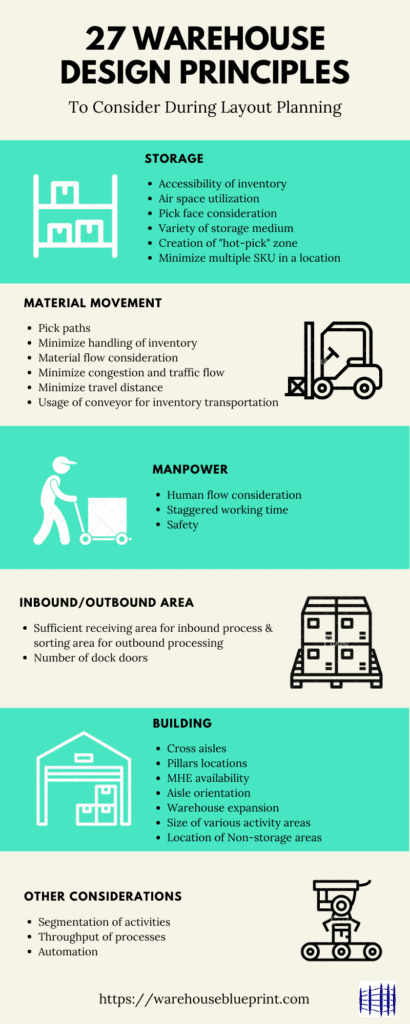Warehouse Design Layout
Do you know what constitutes a good warehouse design layout? Do you know what are the factors that have to be considered during the layout design? Below are some points that have to be considered at the beginning of the design stage.

Storage
Accessibility of inventory
- Different operations require different level of accessibility to inventory. Do consider this during the warehouse design.
- For example, in FMCG (Fast Moving Consumer Goods) industry with less SKU variants and high volume, pallets can be placed in Double Deep racking. It is not required to access to every pallet.
- In high tech goods, where every SKU has to be accessible, conventional selective racking is preferred.
Air space utilization
- Poor air space utilization is often seen in an operational warehouse.
- During the design stage, for the ease of calculation, the beam height for every level of the rack is set to the maximum height recorded of the pallet.
- As such, because majority of the pallets do not require such height, the beams become too high.
- For a good warehouse design layout, the beam heights for each level should be considered during the design phase. This will maximize the vertical space usage.
Pick Face consideration
- Do consider the number of pick faces required at the initial stage.
- Pick faces are bin locations where pickers will pick the inventory given the pick order list.
- Insufficient pick faces will result the pickers to get the inventory from higher levels or more inaccessible locations. This will inevitably slow down the entire picking process.
Variety of storage medium
- Different inventory profile will require different storage medium.
- For example, fast moving SKU with small quantities picked are normally stored in shelving/ flow racks to facilitate ease of picking.
- Slow moving pallets, on the other hand, are stored in racking that has high storage density.
- If space is a constraint, automation can be put in place to fully utilize the area. There will also be improvement in the picking productivity.
- The miniload crane from Schaefer is one such example of automation. Click here to find out more.
Create a "hot-pick" zone
- A specialized area dedicated for fast moving items can be included during the design phase. Usually, this area has a high concentration of pickers fulfilling orders.
- To account for the picking productivity, you should look into the size of this area, the storage medium required, the suitable MHE (material handling equipment) etc.
Minimize multiple SKU in a bin location
- Sufficient storage locations should be a requirement during designing.
- Try to minimize the situation of placing multiple SKU in one bin location.
- An optimal warehouse should have 80% utilization rate for the storage aspect when in operations.

Material
Pick paths
- You have to know how the pickers perform picking of inventory in the storage area.
- What are the possible paths they need to move within the warehouse, e.g. zig-zag, front to back?
- This ties in to the slotting and placement of the inventory in the bin locations.
Minimum handling of inventory
- Avoid unnecessary handling of inventory, especially moving the products from one area to another manually.
- More touch points implies more time and effort required to process the product.
Material flow consideration
- Ensure that material movement within the warehouse is smooth.
Minimize congestion and traffic flow
- Eliminate the possibility of bottleneck point that cause a deadlock in the movement of MHE.
Minimize travel distance
- Large percentage of time is spent by pickers on travelling.
- Reducing travel distance will indirectly reduce the time to move around the warehouse.
Usage of conveyor for inventory transportation
- Rather than manually moving the products around, you can explore the possibility of utilizing a conveyor system.
- In the long run, it will be beneficial if the layout does not change much.
Human
Human flow consideration
- You need to consider the people movement within the operations area to be considered a good warehouse design layout.
- A good practice is to mark out a path for operators to move around within the building.
Staggered working/activity time
- Why is this a factor to consider?
- Because by staggering the activity time for different operations processes, there is a possibility to utilize the same space with different processes at different timing.
- As an example, the area is used in the morning for inbound staging process. In the evening, the same area can be utilized for the outbound dispatch process.
Safety
- This is of utmost importance, primarily because there is a big team of staffs in the operations.
Inbound/Outbound area
Sufficient receiving area for the inbound process
- A good warehouse design layout typically requires sufficient inbound and outbound area for staging purpose.
- Quality inspections, waiting for approval to be putaway, consolidation of inventory are some of the various reasons why unloaded inventory cannot be stored straightaway.
Dock doors
- Dock doors are sometimes segregated by inbound and outbound. This is provided there is sufficient dock doors.
- The reason for the segregation is to prevent crossing of inbound and outbound inventory.
- However, assuming that there are limited number of dock doors, operations will then have to ensure the scheduling of the inbound and outbound trucks do not coincide.
Building
Cross aisles
- In spacious warehouses, pallet racking rows typically are long. They can span from 50 meters to 70 meters.
- A good warehouse design layout practice will incorporate cross aisles (or underpass) for MHE to cross from one aisle to the adjacent one.
- Pickers do not need to travel from one aisle all the way to the end of the row before going into the next aisle.
- Also, some countries do have fire regulations warehouses need to adhere to.
- Any point in the warehouses need to be within a specific distance away from the emergency exit.
- With the cross aisles, the distance can then be controlled.
Building factors (pillars)
- Typical warehouses have pillars around 10 meters apart. However, in certain countries, especially earthquake prone area, the distance might be lesser.
- Regardless, the pillars should not be in the middle of the aisle, blocking the movement of the MHE.
Types of MHE available
- You might be tempted to build upwards the storage medium to occupy more air space.
- However, one aspect to consider is the availability of the MHE in the market that can reach such height.
- Conventional reach trucks normally can reach a level of 6-7 pallet rack high.
- Any higher than that may require specially ordered MHE from abroad.
Aisle orientation
- The rows of pallet racking should be in line with the dock doors rather than perpendicular. This is a common practice.
- The reason is for the ease of inbound to staging to putaway in the storage medium.
- However, there are exceptional cases that have to be considered as well.
Warehouse Expansion
- During the warehouse design phase, you may realize that not the entire warehouse is utilized during the initial period.
- Buffer has to be built in to cater for the year on year volume growth.
- The proposed area for expansion has to be taken into account at this stage.
Size of various areas
- Different operations have various processes. Depending on the complexity, inventory profile and order profile, you will need to calculate the size required for the different areas.
Location of miscellaneous area such as battery charging room, pantry and washroom
- Aside from the operations area, the layout need to cater to other rooms as well.
- These will take up part of the space for the storage.
- These areas should also not be in front of the warehouse, blocking the material flow.
Others
Segmentation of activities
- If possible, clear segmentation of activities should be in place.
- Again, the purpose is to prevent crossing of inventory.
Throughput of processes
- By understanding the throughput of each process, the indicative size of the area can then be determined.
- This will help the overall space usage of the warehouse.
Automation
- You should also consider the possibility of automation.
- Are there too many manual transfer of goods from one area to another? If yes, do consider investing a conveyor system.
- Is space a real constrain? If yes, we can explore storage automation with high density occupancy.
- Are the process complicated, resulting in low throughput and thus requiring a big processing area? If yes, machines should be looked into.
- You should also consider the possibility of automation.


Thanks for pointing out that the aisle orientation in a warehouse will have to be set according to where the doors are. I’m interested in learning more about warehousing storage because I’d like to open my own hobby game store someday. Having a place where I can store goods that can’t be put on shelves yet would surely come in handy.